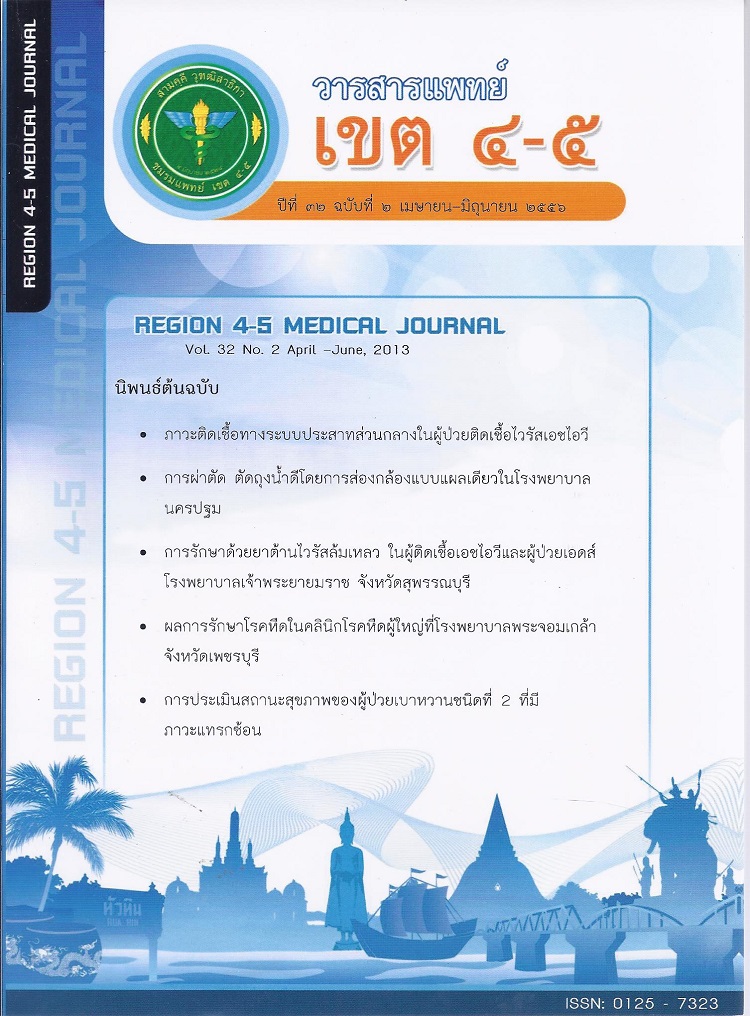ภาวะติดเชื้อทางระบบประสาทส่วนกลางในผู้ป่วยติดเชื้อไวรัสเอชไอวี ในโรงพยาบาลนครปฐม
บทคัดย่อ
Objective: 1. To determine etiology, clinical presentations and outcomes of HIV-infected patients presented with central nervous system infection. 2.To establish clinical and laboratory parameters to differentiate between cryptococcal meningitis and tuberculous meningitis and to identify predictors for mortality among them.
Material and methods: Retrospective study of HIV-infected patients admitted with central nervous system infection was conducted during January 1, 2011 and December 31, 2012. Patients’ characteristics, investigations and clinical outcomes were collected. Clinical and laboratory features were evaluated to identify factors to differentiate among patients diagnosed with cryptococcal meningitis and tuberculous meningitis. Predictive values for mortality of these two conditions were assessed.
Result: There were 98 patients with mean (S.D.) age of 38.5 (10.4) years and 53.1% were male. Median CD4+T-lymphocyte count was 42.5 (4-509) cells/mm3. Median duration of illness was 7 (1-84) days. Of all, cryptococcal meningitis (60 cases, 61.2%) and tuberculous meningitis (21 cases, 21.4%) were the most common central nervous system infections. Alteration of consciousness (52.4% vs 26.7%, p 0.03), hydrocephalus (70% vs 30.2%, p 0.002), cerebral infarction (35% vs 9.4%, p 0.01), low CSF opening pressure (16.5 vs 28.5 cmH2O, p 0.01), high CSF WBC count (62.5 vs 5 cells/mm3, p 0.002), increased CSF protein level (189.5 vs 66 mg/dl, p 0.001) and hyponatremia (129 vs 132 mEq/L, p 0.03) were associated with tuberculous meningitis. Predictors influenced in-hospital mortality among cryptococcal meningitis included depressed level of consciousness (42.3% vs 14.7%, p 0.02), stiffness of neck (80.8% vs 52.9%, p 0.03), absence of headache (23.1% vs 0%, p 0.005) and low CSF WBC count (2 vs 10 cells/mm3, p 0.01). Peripheral WBC count (9,200 vs 6,700 cells/mm3, p 0.04) was the only factor associated with prognosis in tuberculous meningitis.
Conclusions: Various parameters can be used to differentiate between cryptococcal and tuberculous meningitis including level of consciousness, serum sodium level, abnormalities of cranial imaging, CSF opening pressure, CSF WBC count and protein level. Alteration of consciousness, stiffness of neck, absence of headache and low CSF WBC count were associated with dead of cryptococcal meningitis. High peripheral WBC count was the only factor predicting mortality in tuberculous meningitis.
Downloads
เผยแพร่แล้ว
How to Cite
ฉบับ
บท
License
ลิขสิทธิ์บทความเป็นของผู้เขียนบทความ แต่หากผลงานของท่านได้รับการพิจารณาตีพิมพ์ลงวารสารแพทย์เขต 4-5 จะคงไว้ซึ่งสิทธิ์ในการตีพิมพ์ครั้งแรกด้วยเหตุที่บทความจะปรากฎในวารสารที่เข้าถึงได้ จึงอนุญาตให้นำบทความในวารสารไปใช้ประโยชน์ได้ในเชิงวิชาการโดยจำเป็นต้องมีการอ้างอิงถึงชื่อวารสารอย่างถูกต้อง แต่ไม่อนุญาตให้นำไปใช้ในเชิงพาณิชย์



